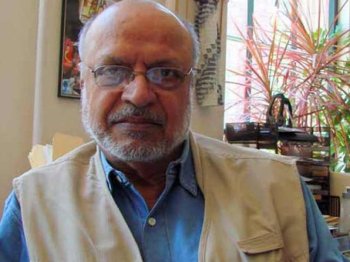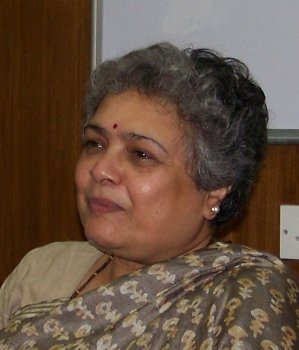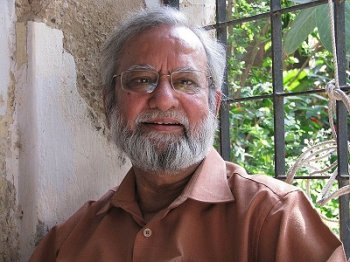
|   |

|   |
 e-mail: leelakaverivenkat@gmail.com Interactions and virtual Spic Macay Convention a unique experience - I June 19, 2020 It was a fateful day in the 1970's when Kiran Seth, a student at Columbia University went "more to see" the concert of the Dagar brothers, Ustad Nasir Aminuddin Dagar and Ustad Zia Fariduddin Dagar at the Brooklyn Academy of Music in New York, the experience turning out to be what he himself calls the 'Black box'. He went in and much later walked out, feet above the ground, not aware of what had hit him inside so intensely. "If I could have such an experience, it could happen to others too," he decided. And the idea of Spic Macay was born! After doing his PhD in Operations Research from Columbia University, he joined Bell Laboratories. The first earnest effort in India at IIT Delhi in 1978, to emulate the New York experience by inviting the Dagar Brothers had about ten people attending with five walking out! The first lec-dem effort at JNU, Miranda House and Lady Irwin College in 1979 with the most acclaimed of artistes of music and dance involved, did not fare much better. But with the never-say-die persistence, helped by a handful of like-minded persons, not to speak of obliging artistes, today's colossus of Spic Macay stands as an exemplary instance of voluntary effort, enabling the exposure of young minds in the country to the best of India's culture and heritage. With all live programming cut by the pandemic crisis, the ever striving Spic Macay team put together a bouquet of select recorded programmes of acclaimed artistes, supplemented by live interactions with them on the internet. Predictably, for volunteers not used to this medium, there were glitches in melding interactive live sessions with the recorded programmes and being able to provide timely links to interested persons. Despite all the drawbacks, the week turned out to be an unusually riveting experience.  Shyam Benegal The post-screening interaction following the film 'Making of the Mahatma' (by Shyam Benegal), proved most absorbing with Shyam Benegal explaining how when approached to do a film on South Africa's Nelson Mandela's victory against Apartheid, he offered instead to do a film based on history closer to his home, also intimately connected with South Africa viz - on Gandhiji's South African stay (a part of his life that nobody including Attenborough's famous film had touched), though this period was really the making of the Mahatma, with his ideas of Satyagraha and non-violence to fight white oppression, which Nelson Mandela too was deeply influenced by. Not a committed Gandhian himself, Shyam Benegal's idea was to portray Gandhi in his human dimension, warts and all, without deifying him, showing how this man acquired the superhuman strength of mind and will to fight for the truth of human dignity in the most trying of circumstances. He made himself the laboratory, with 'My Experiments with Truth' first trying out on himself, what he propounded. While his ideas provided the main ethical and ideational framework on which our constitution rests, the enormous mental and physical burden placed on his wife and family to live up to his ideals could be questioned (as indeed the son did). In Kasturba, Gandhi found a spirited life mate, as determined and with a mind of her own. Even in disagreement on issues with her husband (which was often), her loyalty was total and the foundation of the marriage was never allowed to falter, though one would not have faulted her if at times she had felt that a lesser man as mate, would have made life much easier. And in portraying this lifelong relationship between two strong characters, Shyam Benegal had what he called his 'genuine finds' in young actors Rajit Kapur and Pallavi Joshi. Picked for a different role before being asked to take on the main character, Rajit Kapur who feared that his preparation for the role of Gandhi by reading up his works like 'My experiments with Truth' was woefully inadequate, grew into the spirit of the character in a manner that surprised all. Pallavi Joshi, thrilled at being chosen for the part of Kasturba, was daunted by the prospect of having to live up to a character which Rohini Hattangadi had made so famous in Attenborough's film. One who watches the film cannot remain unshaken by the scene from June 7, 1893, in South Africa's Pietermaritzburg, of that fateful train journey which was to change the course of colonial history - when a young Gandhi, a lawyer, was unceremoniously thrown out of a train despite having a first class ticket! The seed of Satyagraha was sown. The actors, who earned international acclaim for their performances, spoke of the experience as unforgettable, the stay in South Africa including being invited to breakfast by Nelson Mandela! Shyam Benegal's way of never interfering in the actor's interpretation of a character during any scene, made Pallavi doubtful about her performance - till she hesitantly asked if she was on the right track and got the reply, "If there is something I feel lacking, I will tell you. You are doing well." Asked about his approach to music for the film, Shyam Benegal replied that for him, music was an integral part of the film like the actors. Never intrusive, the music here, playing in the background at every point evokes a sense of nationalistic fervour with tunes of 'Vaishnava Janato' and other patriotic tunes in the air. Shyam Benegal spoke of the admirable participation he had from the orchestra in South Africa and how ANC's song at the end had provided an appropriate finale, in a way cementing the closeness with India.  Mrinal Pande Interactions with acclaimed minds pertaining to language, as an all important vehicle of cultural expression, were very informative. Specially memorable was the wonderful exchange with journalist / author / scholar Mrinal Pande in the Rendezvous Series, about the strength of the written word - as in "Sahelare" - "Ham to mar kar bhi rahenge kitabome zinda". (Even after death I will live on in books I have written'). Sangeet being part of 'smriti' and not 'lipi' for Mrinal Pande, discussions on the intricacies of this sastriya kala in English bordered on the ridiculous. Pointing to distortions, she mentioned the senseless linking of our music to the 'apaurusha' Sama Veda, representing an ageless culture of Vedic hymn recitation. 'Om Bhagavate Vasudevaya' for instance cannot be changed, like the Quran recitation early morning from mosques. 'Even Panini cannot create new swaras'. On the other hand, our Kantha sangeet bound in a theory of Ragdari, Chhand and layavishesh with bandishes set to ragas, is man's creative endeavour - where improvisatory brilliance, enables endless newness within set theoretical boundaries. Through the changes of history, the Margi and the Desi have not remained as separate water tight compartments, with Durbar musicians scattering to various smaller riyasats with the nouveau riche willing to give artistes more compensation. Compositions like the Kajri, Chaiti, Bhajan and Thumri, and much else have become part of formal classical Khayal music. Inclusivity in music and theatre evolution (Parsee Theatre for example was in Hindustani and always began with Dhrupad with Muslim singers singing on Hindu gods), while socio-political developments began to show the Hindu / Muslim consciousness. Apart from the Pandits and Ustads, AIR music concerts added the Bai title to female Hindu musicians and Begum to Muslim women musicians, from traditional families. A new fangled effort at 'purity' has tinkered with sahitya of musical compositions. The musicality of bandishes created for sangeet (different from a poetic piece of Hindi literature) have in-built tonal aesthetics suited to the art form, which language changes in the name of 'purity' lose sight of. In all the churning and mixing like "Thumri ang me Khayal" intrinsic identity and the strength of classicism should not be lost. As Mrinal Pande summed up, Sangeet needs its space without religion and politics creating problems.  Shabana Azmi and Javed Akhtar Nothing like poetry to lift one out of the blues and with participants like the very popular couple Shabana Azmi and Javed Akhtar representing an ideal mix of theatre and literature, soaring listener expectations were not belied. The seamless ease of each taking over and complementing the other, without as much as a glance, added its own rhythm to that of the poetry Javed recited. Shabana's comments and reading out the English translations brought home to many the aesthetic intricacies in the verses. Among a clutch of poems recited were "Wo hamara yaad aata hai" recapturing indelible images from one's past in 'that room which tucked me up like a mother her small infant', with the 'insolent loud-mouthed mirror' and hanging pictures looking down with a smile - and one pondering on the nature of 'Waqt' (time). As regaling were Akhtar's observations on the relationship with one's children - recommending a judicious mix of being protective and of leaving them to themselves - and his reference to translation of poetry being like 'pouring perfume from one bottle to another'. Poetry must transcend the words in which it is draped and it must touch the hearer's inside. Speaking of the wide popularity of Urdu (totally Indian origin), he explained the difference between Ghazal and Nazm and the uniqueness of a genre like the Ghazal where each couplet has a completeness (98 % of poetry recited in parliament is ghazal in Urdu rhyme).  Gulam Mohammed Sheikh The exchange of Divyanshu Kumar and Yashwant Parashar with artist Gulam Mohammed Sheikh drew a broad picture of how the famous painter evolved. From being shocked at witnessing women also smoking in Fine Arts College, and having to learn how to communicate in English, in five years, he was on his own painting landscapes and portraits. Showing visuals of his horse paintings he said, 'My horses were not like the horses of Hussein. Mine were more the tonga type.' He explained his technique, how he used a new gel like linseed oil with wax mix developed by Subramaniam at first and then with palette and knife used black pigments from hardware, and how he developed a very inclusive style making collages, creating works like Returning Home After Long Absence. A liberal, his paintings against communalism painted a world like Kabir's Ulat Bansi with the devil quoting scripture, Guru falling at feet of disciple, lion shepherding the cows and the tree upside town. In his journeys, he mentioned being deeply influenced by Abhanindranath Tagore's paintings. His large mural in the entrance of the Charles Corea designed Madhya Pradesh Assembly building, with a speaking tree, mosques, temples and what have you with a chair throne on top with 32 dolls gives a strong political message that one has to deserve to sit on the chair. Interactions and virtual Spic Macay Convention a unique experience - II  Writing on the dance scene for the last forty years, Leela Venkataraman's incisive comments on performances of all dance forms, participation in dance discussions both in India and abroad, and as a regular contributor to Hindu Friday Review, journals like Sruti and Nartanam, makes her voice respected for its balanced critiquing. She is the author of several books like Indian Classical dance: Tradition in Transition, Classical Dance in India and Indian Classical dance: The Renaissance and Beyond. Post your comments Please provide your name and email id when you use the Anonymous profile in the blog to post a comment. All appropriate comments posted with name and email id in the blog will also be featured in the site. |